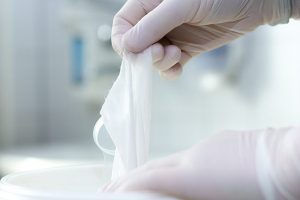“Do I use a disinfectant cleaner or a cleaner?”
This is a question you probably ask yourself when you’re browsing dozens of cleaning products on a shelf at your local store or online. With so many options to choose from, you might not know which product will be best for your home or facility. Unsurprisingly, most people don’t know the difference between a disinfectant cleaner and a cleaner.
However, understanding the distinction between them is critical to creating and maintaining a clean and safe environment. Failing to use the right product for your cleaning tasks increases the risk of cross-contamination, lessens the effectiveness of your cleaning efforts, and contributes to the spread of disease and illness in your business, facility, or home.
Read on to understand the difference between a disinfectant cleaner vs. cleaner, as well as scenarios when you’ll need to use each.

WHAT IS A DISINFECTANT CLEANER?
Disinfectants are regulated by the Environmental Protection Agency (EPA). By definition, a product is not a disinfectant unless and until it is approved by and registered with the EPA to kill bacteria and viruses on surfaces. Disinfectants eliminate certain germs and pathogens — germs they are EPA registered to have “kill claims” against. It is important to read a disinfectant’s label to understand which germs it is effective against.
A product labeled as a disinfectant cleaner does two jobs.
First, it cleans (removes dirt, dust, and grime from surfaces and equipment). Second, it kills specific germs. Disinfecting cleaners come in several forms, including towelettes, sprays and liquid chemicals. Because of their versatility, you can use disinfectant cleaners to both clean and kill certain dangerous bacteria and viruses.
FOR MAXIMUM DISINFECTING POWER, CLEAN BEFORE DISINFECTING
Disinfectant cleaners can both clean a dirty surface and disinfect it. But for the best result you should remove “gross” dirt and/or clean a surface before disinfecting it to ensure the maximum effectiveness. When you remove the dirt, dust, and grime from a surface first, a disinfectant can work optimally to kill the germs it’s intended to kill.
Be careful not to choose just any disinfectant cleaner, though. To determine which disinfectant is best for your facility, office, or home, you’ll need to ask yourself a series of questions. This article will help you consider and weigh important factors when selecting a disinfectant for your facility including the formula, ingredients, and dwell time.
WHAT IS A CLEANER?
A cleaner is designed to only remove surface-level grime and impurities which include dirt, dust, spills, stains, smudges or scuffs, and fingerprints. Cleaning agents fall into four primary categories – detergents, degreasers, abrasives, and acids. They’re usually sold as a towelette or as a liquid chemical. Many people get confused because they think that cleaning is sufficient to remove harmful bacteria, viruses, and fungi that cause contagious diseases from surfaces. However, it’s important to understand that cleaners will not kill germs.
WHEN IS A DISINFECTANT CLEANER RIGHT TO USE?
Aside from your regularly scheduled cleaning you’ll want to use a disinfectant cleaner when:

Bodily fluids come into contact with a surface
- Saliva from sneezing or coughing
- Sweat on gym equipment
- Blood on medical tools or from an accidental office cut
- Vomit from an ill employee or customer
- Fecal matter in your restrooms
A surface is shared by dozens or hundreds of people each day
- Door handles and light switches in high traffic areas like your entry or restrooms
- Copier machines
- Community coffee pots and refrigerators
- Shopping cart handles
- Public restrooms in your facility
When a pathogen may have come into contact with a surface or equipment
- A customer coughs on your reception desk
- An employee sneezes on a keyboard
- A gym member sweats on a bench while working out
- Food containing possible E.coli is set on a counter in the employee break room
- Someone throws up in your bathroom

After raw food has come into contact with a surface
- A knife that has been used to slice chicken or steak
- An employee who cuts themselves drips blood onto a table
- Using the same cutting board for unclean raw fruits or vegetables
WHEN TO CLEAN YOUR FACILITY, OFFICE, OR HOME
To keep your employees, customers, and reputation safe, use a general cleaning plan to complete regular, ongoing cleaning and disinfecting. Be sure that your plan includes a schedule to:
- Remove dust and dirt and clean up spills and other unattractive residues on surfaces
- Remove fingerprints and smudges from surfaces such as windows, touchscreens, etc.
- Kill dangerous bacteria and viruses with an EPA registered disinfectant cleaner
- Frequently remove harmful germs from high touch surfaces
- Regularly disinfect all surfaces where dangerous germs could be hiding
It’s easy to get confused or even frustrated as you’re shopping for disinfectant cleaners and cleaners. Since they’re packaged and promoted in the same ways, you may just assume they do the same thing. Although they may appear to be the same type of product, disinfectants, cleaners, and disinfectant cleaners vary in formula and capability. Now that you understand the difference between what these products do and what to use them for, you can buy the best product for your home or business.
